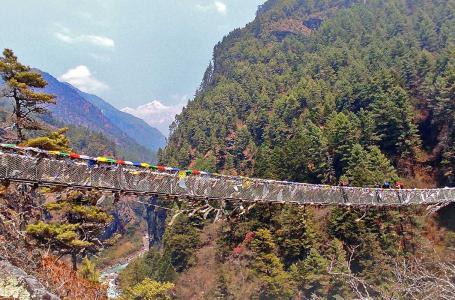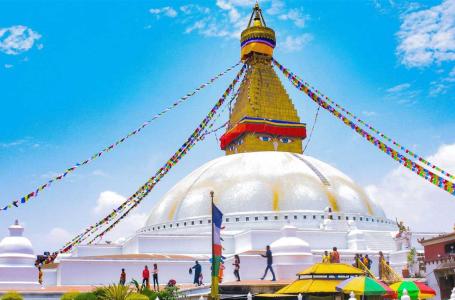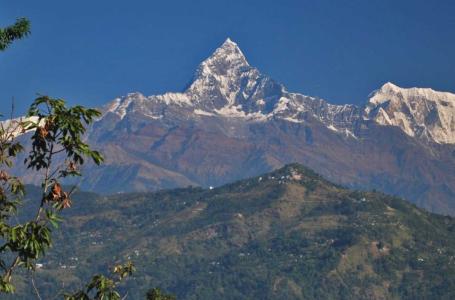Lantang Chandanbari Trek can also be expressed as the Langtang Shin Gompa trek because the highlight of the Chandanbari is Shin Gompa. It is simple in design with no flowery architecture, but its complex history and credible stories are inspiring enough to electrify your soul. Besides, there are many more fascinating highlights of this trek to rate it as one of the best trekking destinations in Nepal: the exquisite Kyanjin Gompa, a hospitable Sherpa Gaon (village), exposed trails, unparalleled views of the Ganesh Himal, a cultural Langtang village, etc.
At a glance, this trek doesn’t look interesting because the mountains barely show up on the trail. But, the Langtang’s fascinating landscapes and the pleasant jungles of diverse wilderness speak enough in favor of this trek. This package lasts only for 8 days, and there is so much to gain from this. The most recommended season to do this trek is Spring and Autumn, but there is nothing wrong with the monsoon as well. However, it is better to avoid the freezing cold of winter for a memorable trip. We provide an experienced and friendly Local Guide, a porter, and all the essentials for a perfect trip. Email us for further information.
Planning a trek to Langtang Chandanbari Trek in Nepal is an exhilarating adventure that requires careful preparation. Plan your trekking itinerary carefully, typically including stops at Dhunche, Shin Gompa, Laurebina, Gosaikunda, and Chandanbari, adjusting it to your pace and preferences. Acclimatization is essential to avoid altitude sickness, so allocate at least one extra day at Gosaikunda or another high point to allow your body to adjust. Prioritize safety during your trek by carrying a fully charged mobile phone and informing someone of your trekking plans. Lastly, savor the journey by immersing yourself in the stunning Himalayan vistas, lush forests, and local culture along the way. Remember to be environmentally conscious, leaving no trace of your presence, and enjoy the natural beauty that the Gosaikunda Trek has to offer.
Autumn (September, October, and November) is the best time for the Langtang Chandanbari Trek. The weather is stable, the skies are clear, and the landscapes are stunning. This season also offers a great chance to find fellow trekkers to join your journey.
Spring (March, April, and May) is another excellent time for the trek. The trails are filled with blooming rhododendrons, and the weather is pleasant. However, there is a slight risk of avalanches in certain areas.
Monsoon (June, July, and August) is not recommended due to heavy rainfall, landslides, and leech-infested trails.
Winter (December, January, and February) brings freezing temperatures, making the trek challenging for most trekkers, especially at higher elevations.
Food and Accommodations:
Throughout the Langtang Chandanbari Trek, you'll find a network of tea houses and lodges in the villages along the trail. These provide accommodation and meals for trekkers. The quality and comfort of tea houses can vary, but most offer basic amenities such as beds with blankets, shared bathrooms (often squat toilets), and communal dining areas. Keep in mind that facilities may become more basic as you ascend to higher altitudes. Hot showers may not always be available, and heating can be limited at higher elevations.
You can also find a variety of food options but it is recommended to consult your guide for better and hygienic options.
The most common way to reach Dhunche, the starting point for the Langtang Chandanbari Trek, is by taking a local bus. Buses depart from the Gongabu Bus Park in Kathmandu. The journey typically takes around 7-9 hours, depending on road conditions, and offers scenic views along the way. And if you prefer a much more comfortable or faster option then you can also opt for a private vehicle.
After reaching Dhunche, we will take yet another vehicle public or private to Syabrubesi which is the starting point of the Langtang trek. Once we reach Syabrubesi, our journey will finally begin on foot and we will trek through lush forests, villages, and scenic landscapes to reach Langtang and its surrounding areas.
To trek to Langtang in Nepal, you will need to obtain the necessary permits, including the Langtang National Park permit and a TIMS (Trekkers' Information Management System) card. These permits are essential to ensure your safety, track trekkers in the region, and support local conservation efforts.
The buses to Syabrubesi leave every morning from Kathmandu. You have two options to reach there: Kakani or Galchi. While the route via Kakani is worn off and far too bumpy, the inexplicable view of the Ganesh Himal excites the journey. On the other hand, the road via Galchi is relatively better (not all blacktopped), but nothing is so interesting about the route.
Via Galchi, the drive takes around 7 hours, but via Kakani, it is 2 hours more. So, the choice is yours. What’s more, catching a bus is a bad option as the condition of the vehicle is worse in many cases, but it saves a lot of dollars.
From Syabrubesi, the upper route to Lama Hotel (via Sherpagaon) invites a range of surprises. Sometimes, it is the pleasant line of prayer-inscribed Buddhist stones (Mani walls) and at other times, it is the views of landscapes, the sweet-smelling forests, or a pleasant Himalayan view. The Khangjim monastery, a paragon of a Tibetan-styled monastery, is the highlight of the journey.
A couple of distances away, there is a quaint village of brave Sherpas, Sherpagaon, where the spirited farm fields lurch by the pace of the wind. There, a rewarding view of the Ganesh Himal gratifies you. Once you reach Rimche, the Langtang Khola joins the trail. Lama Hotel is just a few distances ahead.
The Langtang Khola follows the trail from Lama Hotel to Langtang village. It is an easier walk, but paying attention to the altitude is crucial to avoid any altitude-related complications.
On the way to Ghoretabela, the peak of Langtang Lirung inspires you to continue the trail. Soon after that, the exquisite deserted meadows open up over the canyon. At this point, the views of the down valley are amazing. Cross a suspension bridge to reach the Chyamki and proceed towards the Gumba village.
The mani walls and Chortens grace the pathways. Once you arrive at the Langtang village, make sure your visit the quaint side monastery. It is worth visiting.
Kyanjin Gompa, the largest monastery of the Langtang Valley is colorful with a classic touch of craftsmanship and paintings. To reach Kyanjin Gompa, you will have to follow the similar ups and downs as in other days of trekking. But, remember to proceed calmly as it also aids in acclimatization.
As you move, the white and shiny Chortens, artistic Mani walls, and spinning prayer wheels invite a sense of pleasure and peace in your mind. You will encounter large and black overhanging rocks peering at the infinite chain of snowy mountains. Then, you will reach the Kyanjin Gompa, the exquisite creation.
After spending quality time there, you will descend back to the Langtang for the overnight stay.
Retrace your steps back to Rimche, where the route to Syabrubesi divides into two. Instead of following the upper track, we will follow the lower route and cross a bridge across the Langtang Khola. Then, from half the way, we will turn towards a zigzag path that leads to the Thulo Syabru.
A nice and classic temple at Thulo Syabru is the highlight of this region. People are humble and are eager to share their traditions and their underlying mythical stories with anyone who listens to them. So, spend some time chatting with the villagers.
Two routes leave from the Thulo Syabru. One leads to Dhunche via Brabal while the other to Chandanbari, popularly known as the Shin Gompa. Proceeding to the latter path, you will cross several Chortens and Mani walls. The trails are exposed to the tantalizing views of the landscapes and the farm fields.
At times, the fleeting glimpses of the Ganesh Himal and some parts of the Langtang range cherish your heart and encourage you to explore further. It is a very gratifying walk, and you won’t realize when you have stepped into the Chandanbari. Explore the wonderful Shin Gompa which is not very complex in design but peaceful.
Instead of heading to the Gosainkunda from the Chandanbari, we will proceed to Dhunche. It is a pleasant walk and doesn’t take a long time to arrive at Dhunche.
You may take a break at some villages in the middle and explore the alleys to discover something that the routine trekkers have never been able to. The path fluctuates up and down, as usual, and reaches Dhunche within a short while.
Finally, we will catch a bus or a jeep (as per your interest) to Kathmandu, which is not very far away.
Trip Start and End Point
Kathmandu / Kathmandu
| DATES | STATUS | PRICE | SPACE LEFT | ||||
|---|---|---|---|---|---|---|---|
|
Start date: 05-May, 2025
End date: 12-May, 2025 |
Guaranteed | USD 650 |
2
|
Book Now | |||
|
Start date: 16-Jun, 2025
End date: 23-Jun, 2025 |
Guaranteed | USD 650 |
2
|
Book Now | |||
|
Start date: 23-Jul, 2025
End date: 30-Jul, 2025 |
Guaranteed | USD 650 |
2
|
Book Now | |||
|
Start date: 07-Aug, 2025
End date: 14-Aug, 2025 |
Guaranteed | USD 650 |
4
|
Book Now | |||
|
Start date: 07-Sep, 2025
End date: 14-Sep, 2025 |
Guaranteed | USD 650 |
1
|
Book Now | |||
|
Start date: 05-Oct, 2025
End date: 12-Oct, 2025 |
Guaranteed | USD 650 |
2
|
Book Now | |||
|
Start date: 26-Oct, 2025
End date: 02-Nov, 2025 |
Guaranteed | USD 650 |
2
|
Book Now | |||
|
Start date: 17-Nov, 2025
End date: 24-Nov, 2025 |
Guaranteed | USD 650 |
2
|
Book Now | |||
|
Start date: 04-Dec, 2025
End date: 11-Dec, 2025 |
Guaranteed | USD 650 |
|
Book Now | |||
The Langtang Chandanbari Trek is a scenic trek in Nepal’s Langtang region that takes you through lush forests, traditional Tamang villages, and the famous Buddhist monastery at Chandanbari (Sing Gompa). The trek also offers breathtaking views of Langtang Lirung and other Himalayan peaks.
This is a moderate trek, suitable for beginners with a reasonable fitness level. The trail includes some steep ascents and descents but does not require technical climbing skills.
The trek typically takes 5 to 7 days, depending on the itinerary and trekking pace.
Yes, there are teahouses and lodges in villages like Dhunche, Deurali, Chandanbari (Sing Gompa), and Lauribina. They offer basic accommodation and meals.
Since the trek does not go extremely high, the risk is lower than in the Everest or Annapurna regions. However, if trekking to Gosaikunda, altitude sickness can be a concern. Acclimatizing properly and staying hydrated is essential.
Some teahouses offer Wi-Fi for a small fee, but the connection may be slow. Mobile networks like NTC and Ncell work in some areas but can be unreliable at higher elevations.






